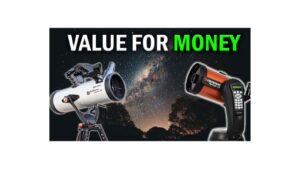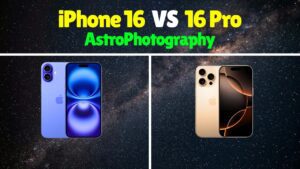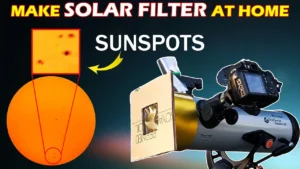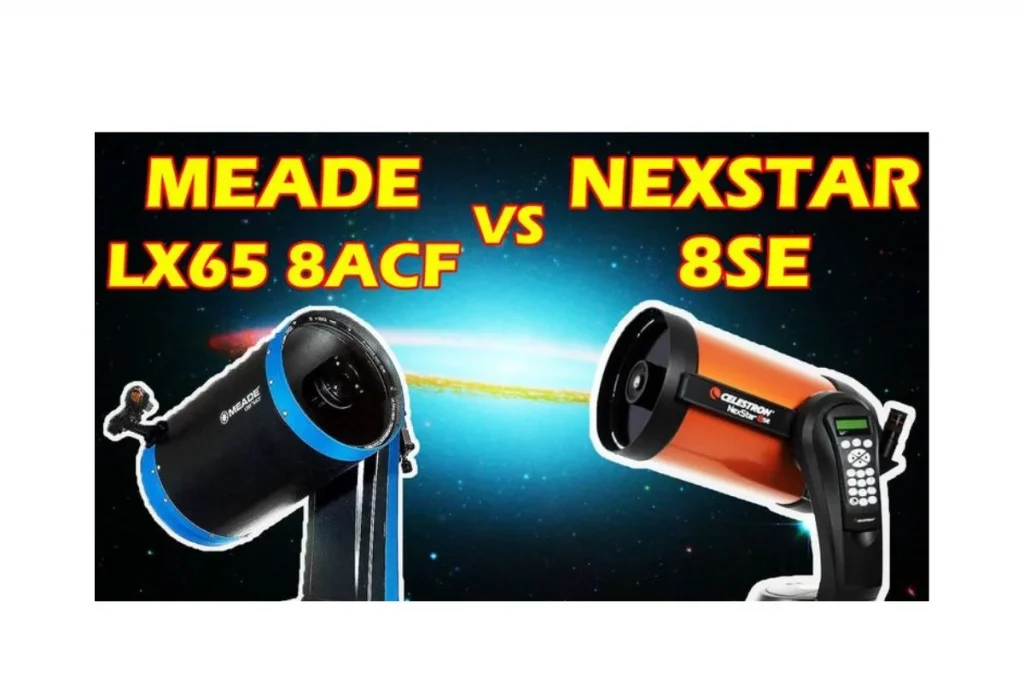
Before we saw the specifications of Celestron’s most popular & quite expensive telescope Celestron Nexstar 8SE. In this article, we will compare Meade LX65 8 ACF telescope with Celestron NexStar 8SE. Both of these telescopes are not for beginners unless you are sure that you are going to pursue your astronomy hobby for the long term.
Similarities between “Celestron NexStar 8SE vs Meade LX65 8 ACF”
Both are these Schmidt-Cassegrain-type telescopes and have an 8-inch aperture. However, the 8-inch aperture comes with their ACF technology also known as Advanced Coma-Free. ACF gives you clear and crisp imagery with no false colors or chromatic aberration.
These telescopes have a focal length of 2032 mm with a focal ratio of 10. Both of them come with a 25mm plössl eyepiece and have a red dot viewfinder technology. They also have almost similar optical tube dimensions.
Differences between “Celestron NexStar 8SE vs Meade LX65 8 ACF”
In terms of weight, Celestron NexStar 8SE weighs around 10kg. While Meade LX65 8 ACF weighs around 18 kg. Both of these telescopes have a single fork alt-azimuth mount. Celestron’s mount can carry weight up to 5kg. However, LX65’s mount can carry 2 telescopes at the same time. That’s why the total weight of the kit is higher than Celestron Nexstar 8SE. LX 65’s mount can carry around a weight of up to 9kg. But you shouldn’t put the whole 9kg just on the single side of the mount.
By using two optical tubes on Meade LX65 8 ACF, you can observe the distant and the magnified sky view at the same time without changing much of the setting. This Setup is much beneficial for astrophotography & deep space stargazing.
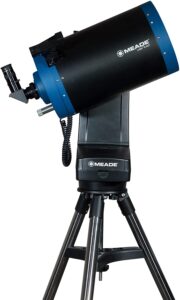
Nexstar’s mount comes with a database of about 40,000 celestial objects while LX65’S mount comes with a database of 30,000 celestial objects. LX65 can be controlled with Audiostar technology with a built-in speaker which can play the information like your guide is guiding you.
What you can see with these telescopes?
Both telescopes are almost identical you can see objects in our solar system, star clusters nebulae & different galaxies. The images obtained by these two telescopes will be good with some minor differences here n there. You won’t find much difference in the image quality between them.
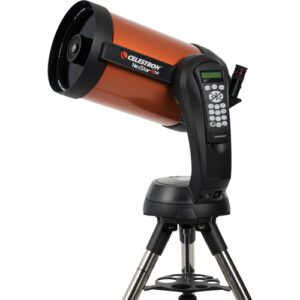
Now, which one should you buy?

Given that these are almost identical telescopes, it might be very difficult to choose from these two.
Celestron’s telescopes are quite beginner-friendly and it won’t take much time to get familiar with the telescope compared to Meade’s. That doesn’t mean Meade is not beginner-friendly. It’s just a little easier on Celestron than Meade. As Celestron is lighter than Meade if you are someone who travels a lot for stargazing then 8SE is a good option.
If you already have a telescope and want to upgrade then Meade’s double mounting can be great for you to have a different perspective at the same time.
When you buy a telescope you also need support for after-sales. Considering that Celestron has a network and dealers around the world which offer these services. While Meade does have a similar network but they often get a lot of complaints & delays. So before you purchase Meade please check the availability of the service in your region.
We hope this article helped you to understand the little difference between these two identical telescopes and helps you to make a better buying decision. If you are looking for a telescope specifically for astrophotography then you need to check this article. You can also find the best suitable telescope for you with our telescope suggestion tool.
NexStar 8SE | MEADE LX65 8ACF | |
Aperture | 203.2mm (8″) | 203mm (8″) |
Focal Length | 2032mm (80″) | 2032mm |
Focal Ratio | f/10 | f/10 |
Optical Design | Schmidt-Cassegrain | Catadioptric |
Weight | 24 lbs (10.88 kg) | 17.46 lb (7.7kg) |
What can you see | Moon, planets, Nebulae, star clusters | Moon, planets, Nebulae, star clusters |
Price |

